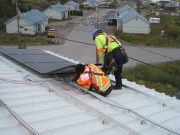I was recently reading a scientific article on energy and was reminded that anything with a temperature above absolute zero (0 Kelvin, or -273°C) has energy in it. Wow, that's cold. But it highlights an important point: anything that is warmer than -273°C has stored energy in it that, if obtainable, can be used. Even on the coldest day of the year it's a lot warmer than -273°C, so there's plenty of energy available for the taking.
The more I thought about this concept, the more I realized it is the principle behind a renewable energy system called geoexchange. Geoexchange systems are also sometimes referred to as ground source heat pumps or low-temperature geothermal systems and often just "geothermal." The latter is unfortunate because it means that geoexchange systems, which are used to heat and cool buildings, are often confused with geothermal systems, which are used to produce electricity. So when someone says "geothermal," it's best to make sure you are talking about the same thing.
Geoexchange is based on some pretty basic heat transfer principles. It works like this: in the winter we need our houses to be warmer on the inside than the air outside. But even if it's cold outside it's a lot warmer than -273°C — we just need a way to harvest some of this energy and bring it inside.
In more temperate regions of Canada it's possible to extract energy from the cold winter air. In Alberta, where I live, it gets pretty cold in the winter making it a lot more expensive to do so. Fortunately, we still have another source of energy — the ground. What's interesting about the ground is that, just under the surface, the ground temperature is fairly constant throughout the year, usually hovering between 4°C and 10°C. The ground is warm because it absorbs the sun's energy — think of the ground as a big battery of sun energy, continually being charged every summer. In the winter, the ground temperature is warmer than the air temperature and can be used to heat our homes — if only we can capture it, that is.

That's where geoexchange systems come in. The main component of a geoexchange system is a heat pump. Air source heat pumps take energy from the air and ground source heat pumps take energy from the ground or a body of water. Both types of heat pumps essentially extract heat, concentrate it and pump it into your home. This technology works so well that you can even use a ground source heat pump to extract the energy from a lake in the winter. By concentrating the heat energy in the water (although cold, there is still energy in it), you can effectively heat a building.
In the summer, these systems work in reverse — just think of your building as one large fridge. Geoexchange systems take the warm air inside your house, compress it and transfer it back out to the air or ground.
The coolest thing about geoexchange systems is that it's not a new technology. These systems have been around for decades, and the technology is proven, robust and only getting better. They're affordable (and for some larger commercial systems are cheaper than conventional systems, meaning instant savings) and can be deployed in houses, commercial buildings and even large industrial buildings. Indeed, in Sweden 40% of homes use geoexchange, and several provinces in Canada even offer financial incentives.
The efficiency of these systems is amazing — for every one unit of energy you need to run the heat pump, you can retrieve two to five units of free energy out of the air or ground — that's 200 to 500 per cent efficient. The highest efficiency natural gas furnace on the market is only rated at 96 per cent.
What's even better is that geoexchange systems run on electricity and can replace your conventional heating system, meaning you avoid the risks (such as reduced air quality and carbon monoxide leaks) that come with a furnace burning fuel inside your house. Geoexchange systems can also replace your air conditioning system and can even help heat your water, meaning they can play an important role in reducing our dependence on fossil fuels for heating and cooling buildings.
If the electricity used to power the heat pump comes from renewable resources (such as hydro, wind or solar), it is possible to heat your building and emit very few greenhouse gas emissions. This switch also encourages the transition to a green electricity grid — something required to reduce our greenhouse gas emissions and mitigate our climate change impacts. In a modelling report commissioned by the Pembina Institute, we found that Canada can significantly clean up its electricity system and that geoexchange systems powered by clean electricity can be part of the solution. As the transportation world is looking to electric vehicles, it's time for the building world to look at electric heating supported by a green grid.
It all goes back to the first law of thermodynamics: energy can be transformed, but cannot be created or destroyed. Geoexchange systems very efficiently concentrate and shift usable energy from outside your home into your home, making it comfortable to live.
To find out more about geoexchange, read our fact sheet.







